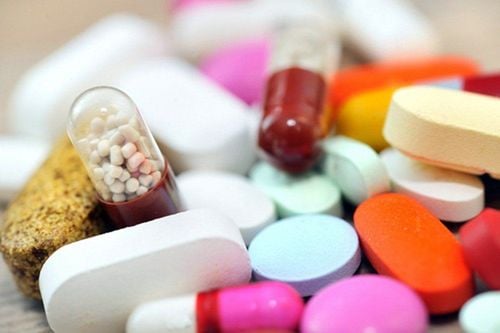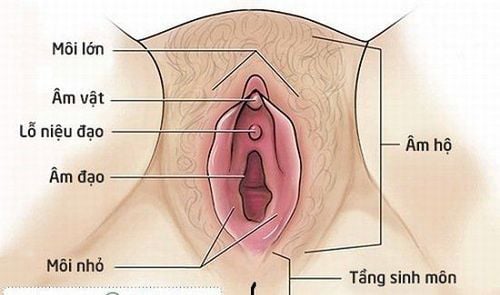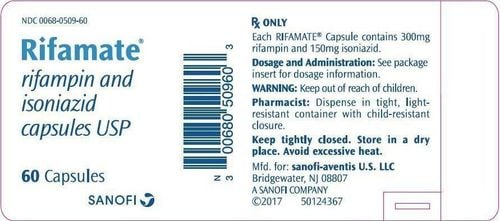This is an automatically translated article.
Cefepime gerda 1g is indicated for use in the treatment of diseases: Lower respiratory tract infections, urinary tract infections, skin - skin structure infections, abdominal cavity infections, sepsis and gynecology. In addition, the drug is also used in cases of neutropenic fever, bacterial meningitis in children.
1. What is Cefepime gerda 1g?
What is Cefepime gerda 1g? Cefepime gerda 1g is a powder for injection with the main ingredient being Cefepime with a content of 1g (Cefepime in the form of a mixture of Cefepim hydrochloride and Arginin)The drug is manufactured by LDP Laboratoires Torlan - Spain, circulated in Vietnam with registration number VN-17366-13.
2. Uses of Cefepime gerda 1g
With the main ingredient is Cefepim 1g - a bactericidal antibiotic with the mechanism of inhibiting the synthesis of bacterial cell walls, the drug is used to support the treatment of infections caused by susceptible bacteria. as follows:Community-acquired pneumonia : Caused by Staphylococcus aureus and other strains; Chronic bronchitis and acute bronchitis : Caused by Streptococcus pneumoniae, Haemophilus influenzae...; Urinary tract infections: Due to Escherichia coli, Pseudomonas aeruginosa.. and other strains; Skin and skin structure infections : Staphylococcus aureus strains...; Biliary tract infections and peritonitis: Caused by Escherichia coli, Pseudomonas aeruginosa.
3. How to use Cefepime gerda 1g and appropriate dosage
3.1 How to use The drug is only used under the prescription of a doctor - pharmacist or professional person. Drugs for intramuscular or intravenous administration.
Intramuscular: Mix 1g Cefepim with 2.4 ml of solvent (distilled water for injection or other suitable solvents) to get a solution concentration of 240 mg/ml. Intravenous infusion: Mix 1g or 2g of Cefepim to obtain a drug concentration of 20 or 40 mg/ml, respectively, or depending on the appropriate dose concentration prescribed by the doctor. 3.2 Dosage Mild to moderate infections: 0.5 - 1 g/12 hours;
Severe infections:
Urinary tract infections, skin and skin structure infections: For patients older than 12 years, intravenously 2g/time, every 12 hours; Pneumonia and bacteremia: Use 2g/time, every 12 hours; Life-threatening infections: Use 2g/8 hours, IV injection.
Children less than or equal to 40kg: 50 mg/kg every 8 to 12 hours; Children under 2 months: 30mg/kg every 8-12 hours. Do not exceed the recommended adult dose; For renal failure with ClCr < 50 ml/min, adjust dose accordingly.
4. Side effects encountered when using Cefepime gerda 1g
Some side effects when using Cefepime gerda 1g may be encountered by readers as follows:
Common: Diarrhea, rash, injection site pain... Uncommon: Fever, headache, increased eosinophils, agranulocytosis, nausea, vomiting, mycosis, increased liver enzymes....; Rare: Anaphylaxis, edema, hypotension, colitis, vaginitis, arthralgia, confusion...; When experiencing any side effects, you should stop using the drug and consult a doctor or professional person to ensure a suitable and safe treatment plan when using the drug.
5. Caution and caution when using Cefepime gerda 1g
Before using Cefepime gerda 1g, it is necessary to check whether the patient is sensitive to any of the ingredients of the drug; If used in penicillin-sensitive patients, caution should be exercised because of cross-allergies between beta-lactam antibiotics; Patients with impaired renal function should be cautious and adjust the dose accordingly; Pseudomembranous colitis has been reported with almost all antibiotics, with the exception of cefepime, so caution should be exercised when prescribing it to these patients; Long-term treatment with Cefepim can accelerate the growth of non-susceptible organisms.
6. Can pregnant and lactating women use Cefepime gerda 1g?
Pregnant and lactating women are best not to use it unless absolutely necessary. If required, follow the doctor's instructions for safe dosage and use.
7. Drug interactions
Cefepime gerda 1g when used with other drugs that may interact, you need to be careful and careful in combining drugs:
Cefepime combined with high-dose Aminoglycosides can increase the possibility of toxicity on the kidneys and ears of aminoglycoside antibiotics; Concomitant use of other cephalosporins with potent diuretics such as furosemide may cause nephrotoxicity; Also be aware of drug/test interactions: Cefepime may interfere with the reporting of Urine Glucose test results when using Clinitest because it will report a false positive. Cefepime gerda 1g medicine is indicated for use in supporting the treatment of diseases: Lower respiratory tract infections, urinary tract infections, skin - skin structure infections, abdominal cavity infections, sepsis and gynecology.
To ensure effective treatment and avoid unwanted side effects, patients need to strictly follow the instructions of the doctor, professional pharmacist.
Follow Vinmec International General Hospital website to get more health, nutrition and beauty information to protect the health of yourself and your loved ones in your family.
Please dial HOTLINE for more information or register for an appointment HERE. Download MyVinmec app to make appointments faster and to manage your bookings easily.













